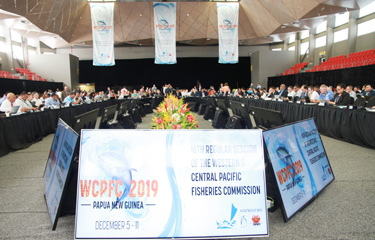Lack of effective RFMO management of tuna fisheries threatening US commercial entities

Regional fisheries management organizations (RFMOs) play an important, though sometimes opaque, role in fisheries management and governance. These organizations are formed by countries that have fishing interests in those areas or stocks.
This article is the second in a four-part series covering the role regional fisheries management organizations in the global seafood trade. The series is intended to help seafood companies better understand the role and impact of RFMOs and the opportunities to engage with those bodies. The previous article introduced the organizations as a whole and focused on tuna RFMOs in the Pacific Ocean.
There are 17 regional fisheries management organizations (RFMOs) in total, but most attention tends to fall on the five major tuna RFMOs that are responsible for about 91 percent of the world’s oceans. These five tuna-focused RFMOs are international organizations formed by countries with fishing interests in a geographical area or highly migratory stock. These RFMOs create fishing limits on stocks in the high seas in order to manage long-term healthy populations and can monitor technical measures used by fisheries. The tuna RFMOs regulate rules and quotas for the participating member-countries to follow in order to sustain healthy tuna stocks in the geographical areas they cover.
Two of the five tuna RFMOs – the Western and Central Pacific Fisheries Commission (WCPFC) and the Inter-American Tropical Tuna Commission (IATTC) – manage tuna fisheries in the Pacific Ocean, covering from the coasts of North America and South America all the way to the coasts of Russia, China, Southeast Asia, and Australia.
The WCPFC is an international fisheries agreement to ensure long-term conservation and sustainable use of highly migratory stocks in the Western and Central Pacific Ocean. The RFMO has 26 members that collectively manage the highly migratory stocks of tuna species including albacore, skipjack, and yellowfin, and billfish species (marlin and swordfish).
The WCPFC engages in the collection and submission of stock data, which it generally receives from its participating members, in order to better predict stock numbers. The WCPFC also tracks changes of historical patterns of fishing fleet behavior in the Western Central Pacific Ocean (WCPO), which have changed in recent years due to technological developments and improved vessel design. Recently, the WCPFC has studied how vessel movements are impacting local and regional ecosystems. And the organization conducts regular reviews of measures
The WCPFC currently has two major programs of focus: the Pacific Tuna-Tagging Program (PTTP) and the West Pacific East Asia Project (WPEA). The PTTP is a joint research project to improve stock assessment and management of skipjack, yellowfin, and bigeye tuna in the Pacific Ocean. Its aim is to reduce uncertainty in tuna stock assessments by collecting data on age-specific rates of movement, mixing of the species at the equator, and local exploitation rates and productivity in different parts of the Pacific Ocean.
The WPEA project intends to build the capacity and participation of the Philippines, Indonesia, and Vietnam in the work of the RFMO. These countries form part of the western boundary of the Pacific Ocean and are a major warm pool of marine ecosystems. The project aims to address two main barriers to the WCPFC: incomplete knowledge about oceanic ecosystems and a lack of data. The WCPFC has requested its members provide more-reliable data so it can make estimates of tuna stocks, bycatch levels, and what gear is being used in the fisheries it covers.
The IATTC’s mission centers on the conservation and management of tuna in the eastern Pacific Ocean. It has 21 members and three major projects of focus: the Eastern Pacific Tuna-Tagging Program (EPTTP), the Bigeye Tuna Statistical Program (BTSP), and the International Dolphin Conservation Program (IDCP).
The EPTTP is focused on tagging skipjack and bigeye tuna to collect statistical data on the migratory patterns and lifecycle of these species of tuna. This helps the IATTC scientific committee better protect and estimate stocks to manage the fishing of the species. The BTSP is a statistical document that must be submitted to the IATTC when importing bigeye tuna into a member area. This helps provide data on the amount of bigeye tuna being fished and imported into different areas, ultimately allowing the IATTC to create more-accurate quotas, whether reducing or increasing those quotas steered by better stock data.
Lastly, the IDCP is a program covering the Eastern Pacific Ocean that aims to reduce incidental dolphin mortalities in tuna fisheries. A component of these aims is to develop a means of capturing yellowfin tuna that will not result in the capture and mortality of dolphins, which are currently used as indicators of tuna schools as the two frequently travel together.
These tuna RFMOs are expected to develop harvest strategies, fishing quotas, stock-rebuilding plans, and to collect data on vessels deemed to be involved in illegal, unreported, and unregulated (IUU) fishing – but historically, some of them have not been very effective at the job, according to Tom Pickerell, the executive director of the Global Tuna Alliance.
“The tuna RFMOs are all mandated to deliver harvest strategies. It’s just some of them are nowhere near finishing those and it very much depends on the species and region," Pickerell said. “That’s something the International Sustainable Seafood Foundation (ISSF), via assessment of stocks against the Marine Stewardship Council standard, has done and we’ve got a sort of analysis of how the tuna RFMOs are performing – and it’s not great. I think there are only two stocks globally that are actually in a good spot, as they’ve got their harvest strategies in place.”
The Global Tuna Alliance (GTA) has undertaken the mission of increasing engagement of non-producer seafood companies with RFMOs in order to support and urge RFMOs to improve their management for the overall interests of a healthy, long-term seafood industry, Pickerell said.
“If there is no tuna, they [retailers] can’t sell it and the irony is, If the retailers can’t sell tuna, they will just sell other stuff. But the fishermen who fish it, what are they going to do? So, it’s a mad situation,” Pickerell said.
Pickerell said the seafood industry can potentially have substantial influence over RFMOs’ management of key seafood resources, but currently, they rarely engage with these entities, but this is starting to change.
SeaPact, a pre-competitive collaboration of North American mid-supply chain companies, recognizes the importance of this engagement, according to Hamish Walker, the chief operating officer of Denver, Colorado, U.S.A.-based Seattle Fish Company, a Sea Pact member.
“It is really so strongly in our interest that there are lots of different sources of good sustainable tuna,” he said. “Anything we can do to promote that, helps our business because it gives us options, gives us volume, that we can tap into and gives us business for the long term.”
Proper scientific management can have market impacts beyond stock management, such as initiatives to reduce the mortality rates of key species and bycatch. But it can also have a direct impact on the commercial success of the products emerging from the fishery, Walker said. He related the story of how Sea Pact pushed the U.S. delegation to the WCPFC to encourage it to maintain the requirements for Marine Stewardship Council certification of several of its tuna fisheries.
“We heard the U.S. delegation are not super-warm towards MSC in the first place and were not particularly concerned about the loss of the status. Part of what [Sea Pact was] trying to convince them was that MSC is a recognized certification [and that] it is really important to U.S. businesses commercially,” Walker said. “There is a U.S. financial and commercial interest in keeping MSC certification, and we wanted to make sure that interest came across. The reason for the concern was WCPFC doesn’t have a harvest strategy and that’s a requirement for the MSC.”
The IATTC has also struggled to develop species-specific harvest strategies for tuna stocks, Walker said. The U.S. may be more focused on the imposition of more-stringent management measures, but a lack of harvest strategies is impeding the RFMO’s movement toward the adoption of sustainable practices, Walker said.
“The U.S. delegation’s viewpoint was focused on the conservation management measures which are more important to them because they’re enforceable, whereas the harvest strategy is a more general, ‘How do we keep this fishery sustainable?'" Walker said. “If you don’t have a strategy, what rules are you going to enforce and what are they informed by? So that means they’ve got some rules they can enforce, but without that overall direction of the fishery, it leaves us a little bit unsure as to whether that fishery has got a sustainable future and whether it’s in a good spot or not.”
Photo courtesy of Fatu Tauafiafi






Share